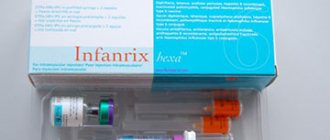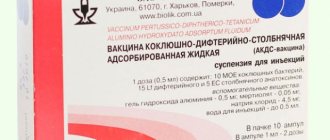When is vaccination prohibited?
If there are contraindications, vaccination is strictly prohibited due to the high risks of complications.
Contraindications to BCG:
- the child was born prematurely weighing no more than 2.5 kg;
- the presence of acute viral and infectious diseases;
- a woman is diagnosed with intrauterine infections during pregnancy;
- hemolytic disease;
- sepsis, as an independent disease or resulting from other diseases;
- deviations in the condition and functioning of the central nervous system, accompanied by severe, intense symptoms;
- presence of cancer;
- skin lesions;
- primary type immunodeficiency;
- HIV infection of the mother.
It is prohibited to vaccinate newborns when the child is in close contact with tuberculosis carriers. These contraindications for BCG apply to both primary vaccination and BCG revaccination at 7 years of age and later.
Other contraindications to revaccination are the need for radiation therapy, taking medications from the group of immunosuppressants.
Despite all the indications about the need to get vaccinated, contraindications to vaccination cannot be ignored, because in this case, complications after vaccination are highly likely to occur.
If a child has diseases that make it impossible to carry out BCG, BCG M is prescribed - a dry vaccine produced in powder form, which must be diluted with saline before use. Contraindications for BCG M:
- the child's weight is less than 2.5 kg;
- the presence of 3 and 4 degrees of intrauterine malnutrition;
- acute diseases or exacerbation of chronic diseases - vaccination is carried out after the child recovers;
- malignant neoplasms;
- skin diseases with extensive lesions;
- severe and moderate diseases of the central nervous system.
BCG M is not performed if the mother has AIDS.
Importance of the BCG vaccine
Today, tuberculosis is one of the most important problems for modern medicine. The mortality rate for this pathology is higher than for cardiovascular diseases and cancer.
The disease is dangerous for the health of the child due to the high probability of complications. Failure to promptly treat the disease can lead to death. Vaccination with BCG significantly reduces the risk of infection with Mycobacterium tuberculosis and increases the body's resistance to the causative agent of the disease. Even if infected, a vaccinated baby has a greater chance of preventing serious consequences than others.
BCG can also protect against:
- disseminated forms of the disease;
- meningitis.
The World Health Organization Council decided that it is better to carry out vaccinations in the maternity hospital. Therefore, the drug is administered during the first week of the baby’s life. The validity period of BCG is 6-7 years. After this period, the child is revaccinated.
Thus, the main advantage of the drug is the protection of the child’s body from the effects of Mycobacterium tuberculosis and the development of possible consequences for several years after administration of the drug.
You should not refuse to prevent the disease without compelling reasons, as this can cause enormous harm to the baby’s health.
Possible consequences
In most cases, BCG vaccination for newborns and revaccination is easily tolerated, without negative consequences. But it happens that complications arise. Side effects from BCG vaccination occur due to the individual characteristics of the body or if there are contraindications to the vaccine.
If after the vaccine is administered the skin at the injection site turns red, this is a normal reaction of the body. Redness may persist for up to 6 months after BCG, or the symptom may disappear after 1-2 weeks, everything is individual. If the skin does not turn red after the vaccination, this should alert you. Reasons for the development of complications after vaccination:
- choosing a low-quality drug for vaccination;
- incorrect administration of the injection, for example, too deep injection of the vaccine;
- the child’s immunity is insufficiently developed, which is why the body is unable to resist the bacteria planted in it.
The most common complication after vaccination (both during primary vaccination and revaccination) is an increase in body temperature to +38°C.
This side symptom is a variant of the norm, but only when there are no other symptoms and the temperature returns to normal within 2-3 days.
If the temperature remains high after 3 days, you should consult a doctor. Perhaps such a reaction is a sign of consequences, complications of BCG, or is associated with the individual characteristics of the body.
Cold abscess
Side effects of the BCG vaccine, such as the formation of cold abscesses, are observed more often than other complications, but are not dangerous and in most cases resolve on their own.
The reason for the formation of the pathology is the introduction of the vaccine not by the intradermal method, but inside the muscle or subcutaneously. A cold abscess is the formation of an infiltrate under the child’s skin, which adheres to adjacent soft tissues. Most often, cold abscesses are not accompanied by a deterioration in the child’s general condition, but the presence of concomitant side symptoms cannot be excluded.
Side effects of BCG in the form of a cold abscess can be manifested by the following symptoms:
- general intoxication of the body;
- increased body temperature;
- deterioration of general condition.
Often such abscesses open on their own.
If this does not happen, appropriate treatment is carried out. The pathological focus is opened, its contents are removed, the soft tissues are sutured, and supportive therapy is carried out. What do you think are the most important factors when choosing a medical facility?
Lymphadenitis
The most common complication after the BCG vaccine is lymphadenitis. It is an inflammatory process that forms in the armpit. In the early stages of the development of lymphadenitis, there are no signs. Gradually (1-2 months) after immunization, the lymph node in the armpit slowly enlarges, but touching it does not cause pain.
Over time, mild signs of general intoxication may appear. Less commonly, suppuration of the lymph node occurs. Therapy for lymphadenitis resulting from BCG involves surgery, during which the affected lymph node is removed. Chemotherapy is used for prevention purposes.
Ulcers
BCG can also have consequences such as the formation of ulcerative formations on the surface of the skin. Ulcers appear a few weeks to a month after BCG in newborns or after revaccination per year.
Ulcerative formation appears in the form of ulceration of the upper layer of the skin. Therapy is medicinal, the ulcers are regularly sprinkled with the drug Isoniazid. In order to prevent secondary infection, the use of local medications that have an antibacterial effect, for example, Tetracycline ointment, is prescribed.
Keloid scar
Complications after BCG, such as the formation of keloid scars, are observed if BCG vaccination in children was given intradermally. The peculiarity of the development of keloid scars is that they appear approximately 12-14 months after the vaccine and are no different from the keloid scar formations that form in humans after surgical interventions.
Scars can be of 2 types - non-growing and growing. If the scar is growing, it has an irregular shape, the skin color is purple, and a capillary network develops in the body of the scar. A growing keloid develops slowly, but the process of its enlargement is irreversible. The formation of a keloid is accompanied by itching of the skin; rarely, touching it can provoke the development of painful sensations.
To slow down the rate of keloid development, conservative therapy is carried out, during which physiotherapeutic techniques are prescribed. It is rare that medications can completely stop the further development of a keloid.
Surgical methods for removing a keloid scar are rarely used, for special indications and only if the keloid has formed after vaccination in a newborn. If a complication arose after BCG revaccination was performed, surgical removal of the keloid is strictly prohibited.
Ostitis
BCG vaccination in children can lead to damage to bone tissue and the musculoskeletal system with the development of a corresponding clinical picture. The lesion site is strictly limited. Osteitis appears in children in the age group from 6 to 12 months. Osteitis are inflammatory lesions on bone tissue.
To confirm the diagnosis, a comprehensive examination is required, including laboratory tests - urine and blood, as well as an x-ray of the sternum.
Treatment of osteitis that occurs after BCG vaccination is carried out using physiotherapeutic procedures - application of a semi-alcohol compress, ozokerite, paraffin application, laser irradiation, UHF therapy, iontophoresis.
Generalized BCG infection
Complications of BCG vaccination in most cases are not dangerous, they are easily treatable and do not carry the risk of consequences in the future. The most dangerous and extremely rare complication is the development of a generalized BCG infection, which leads to death. The causes of generalized infection are congenital immunodeficiency; with revaccination, granulomatous disease occurs in a chronic form, combined immunodeficiency.
A generalized infection occurs with tuberculosis of the lymph nodes, total damage to internal organs and life support systems. A fatal disease develops within 12 months from the date of injection.
Reaction to the vaccine
Many parents mistakenly believe that the manifestation of various kinds of reactions (for example, itching, redness, fever) refers to negative consequences. This is not true at all. Such phenomena are considered normal. Let's look at the reactions to BCG that are most often observed:
The appearance of pus is a normal reaction. A month later, the injection site begins to fester and crust over. It should be noted that the skin around this area should not be affected - there should be no redness or swelling. The abscess will heal within six months. During this period, the affected area does not need to be treated with antiseptics/antibiotics. Iodine mesh should also not be applied. Squeezing out pus is prohibited.If a lot of fluid comes out from the affected area/injection site, you need to remove it with gauze/bandage. If the area around the abscess is red and swollen, you should consult a doctor. This is due to the fact that an infection could have gotten into the wound and needs to be treated. If the wound suppurates several times, a diagnosis of BCGitis is made. The child must undergo a complete, thorough examination.
- Itching. Such a symptom after vaccination may indicate an allergic reaction or the formation of a keloid scar. In this case, you need to contact an infectious disease specialist.
Redness. During the vaccination reaction, a change in skin color is considered normal. Redness can also be observed after the pus has drained; during this period, a scar forms on the skin. It should be noted that the redness should not extend beyond the affected area. The formation of a keloid scar (characterized by swelling and redness) without infection is not a pathology.- Swelling. After the drug is administered, the injection site begins to swell. After a couple of days, the swelling subsides. It should be noted that as soon as the swelling goes away, the grafting site should not differ in any way from the adjacent area of the skin. Pimple and suppuration appear only a month and a half after administration of the drug. It should be noted that during this period the abscess should not swell.
- Temperature increase. As for this reaction, an increase in temperature is observed in rare cases. As a rule, it does not exceed 37.5 degrees. An increase in temperature is typical during the formation of an abscess. If an increase in temperature is observed immediately after administration of the drug, you should visit a doctor.
Inflammation. If, after a month and a half after the vaccination, the injection site becomes inflamed, there is nothing to worry about. If you observe the formation of a red pimple, an abscess or a vesicle with liquid, and the tissue around this place is not affected, this is normal. A doctor should be consulted when inflammation is observed outside the injection site.
What to remember
When prescribing BCG, contraindications cannot be ignored. Due to the fact that the vaccine is administered when it is prohibited, complications of varying severity arise.
Complications after BCG vaccination, especially after revaccination, can be caused by the fact that the doctor’s recommendations regarding skin care at the injection site are not followed.
If, after vaccination in a newborn or revaccination in older children, side symptoms appear, parents should follow these steps: show the child to the doctor as soon as possible, and before that do not perform any manipulations with the site of the vaccine. Treatment aimed at eliminating side symptoms can only be prescribed by a doctor.
It is important to remember that any complications from BCG do not occur immediately. The development of the pathological process sometimes takes from several weeks (in newborns) to 12 months (in older children during revaccination). Therefore, parents should periodically examine the skin and consult a doctor if there is the slightest change in its condition or appearance.










